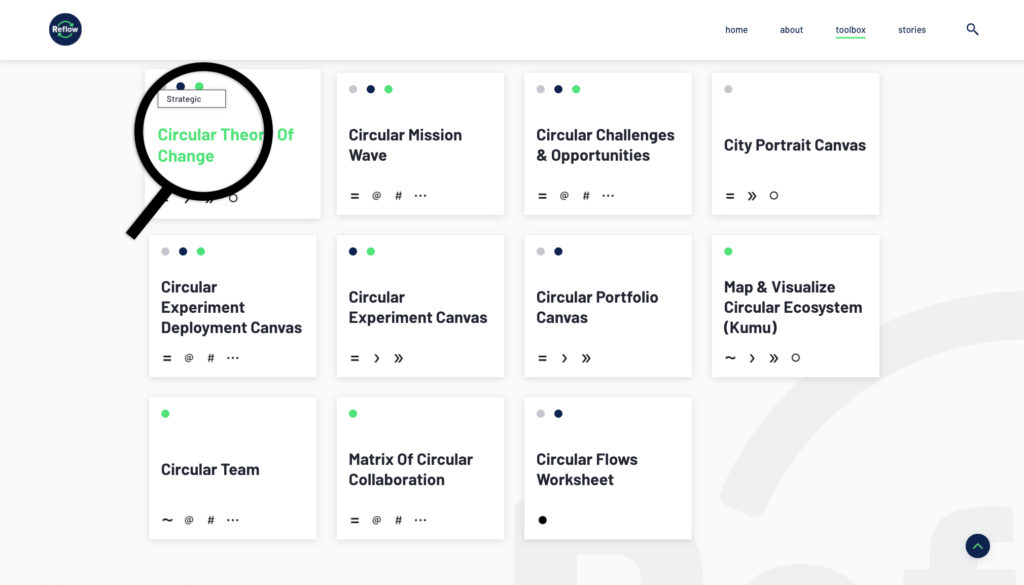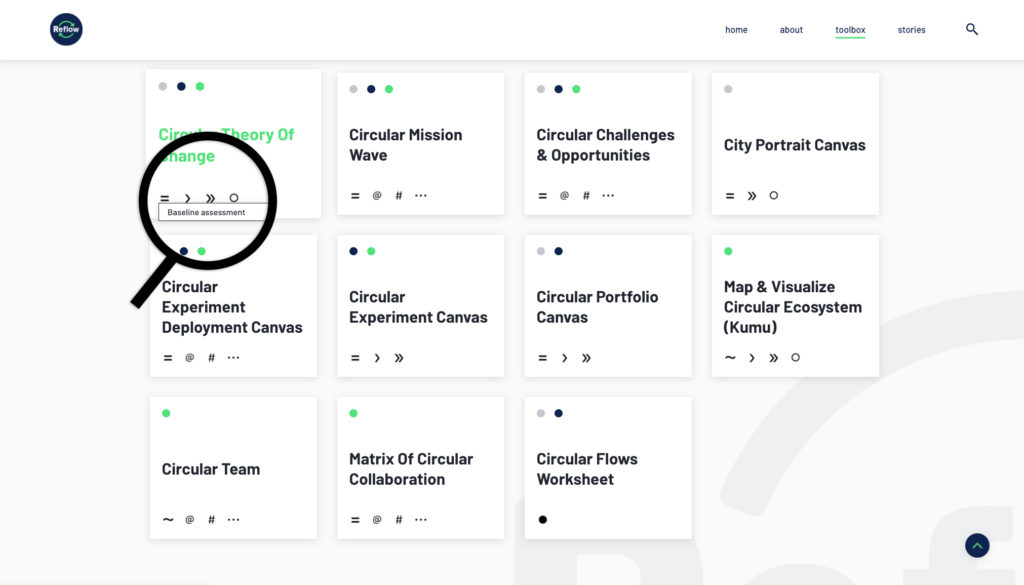Collaborative governance as infrastructuring
A REFLOW Toolkit
The REFLOW Collaborative Governance Toolkit (RCGT) is a practical resource designed to support collaborative transition paths towards circular and regenerative cities.
In REFLOW we understand collaborative governance as a long term, systemic process of steering and coordination of all the different levers in cities – policy, regulation, funding, knowledge, collective intelligence, and many others – in a way that allows distributed capacity, legitimacy and agency for (circular) change across public and private sectors.
This infrastructuring operates across three dimensions:
- STRATEGIC, focused on creating synergies and alignment across different actors and agendas so that their resources can be made widely accessible and pooled towards collective impact;
- OPERATIONAL, focused on building operational capacities and tools in a way that allows different circular experiments and activities to exist as a highly connected, systemic process;
- RELATIONAL, focused on building trust, distributed agency and legitimacy, developing shared value
The figure below (Figure 1) provides an overview of the Toolkit framework based on those three logics.
It is worth noting that resources and tools (both present and upcoming) do not only cover governance-specific aspects such as organisational arrangements and actors’ coordination, but include broader aspects, such as visioning and roadmapping, planning, urban assets management, and many more. All these tools entail different levels of complexity and articulations, highlighting that often the overall transition journey is far from being linear and that ‘entry points’ can vary.
 Fig. 1 RCGT Framework
Fig. 1 RCGT Framework
Target-Groups
The RCGT is primarily addressing the following target groups:
- Practitioners. Professionals working within both public and private organisations, and with expertise in designing, facilitating and steering innovation processes in a broad sense. This includes designers (particularly systemic, strategic, and service designers); process facilitators and community builders; project, service or knowledge managers, as well as entrepreneurs.
- Decision makers. Representatives from local and regional authorities with decision capacities with respect to new programmes, projects, and policies in different sectors, including economic, social, and environmental affairs. Also technical experts that work in support to decision makers, providing evidence and data.
- Researchers. Research experts working both within universities or other public and private research-oriented organisations, with key reference to researchers working in the fields of circular economy, transition theories, sustainable urban development, governance.
Toolkit architecture
The overall architecture of the Toolkit (Figure 2) has been designed to be user friendly and easy to navigate, in an overall journey that is meant to be simple, intuitive and designed through multiple, yet closed loops (e.g. contextualising tools within specific options of applications; providing stories that explain how a given tool or method has been concretely applied, etc.). The whole design process is meant to be iterative, and follow the needs of the pilots and their local stakeholders.
 Fig. 2 Architecture tree of the website
Fig. 2 Architecture tree of the website
This structure is captured in the Menu, which includes the following sections, each bringing the user to discover the Toolkit via different ‘calls to action’:
? Home: it provides a quick intro to the Toolkit, through three subsequent ‘calls to action’ that bring the user to discover the different parts of the RCGT in its standing fashion.
? Journey: it provides the user with an overview of the Toolkit framework so as to help the flow of navigation and retrieve of resources.
? Toolbox: it is the core of the Toolkit, with various resources and tools organised according to the framework. All tools are tagged and can be filtered according to two core categories: Infrastructuring dimension, i.e. strategic, operational, relational (Figure 3); – REFLOW levers (Figure 4).
? Stories: this section attempts to host learnings and experiences that can be either directly or less indirectly connected to the resources made available. [Text Wrapping Break]
 Fig. 3 Infrastructuring tag
Fig. 3 Infrastructuring tag
 Fig. 4 Levers tag
Fig. 4 Levers tag
Toolbox
Rationale for tools selection
In this Toolkit – and within the design process that underpins it – we adopt a portfolio logic1 as an approach to trigger experimentation and learning across a full-stack designed transition. The intention is to support the pilot cities (and cities beyond REFLOW) in articulating their circular action plans with a systematic perspective, defining a set of strategically connected and mutually reinforcing activities and experiments that offer the highest potential of learning, create new value and guide strategic investments.
The Toolkit offers 11 tools: some of them are strictly connected to the portfolio logic, some others are more general in scope and attempt to cover broader aspects of design and planning around governance.
What follows is a brief overview of the 11 tools provided so far.
- Circular Portrait Canvas: designed by Circle Economy, this canvas helps assess city strategies, policies, and programmes in a holistic way, integrating environmental, social and economic, as well as local and global considerations.
- Circular Challenges and Opportunities: A tool that helps collaborative brainstorming on circular challenges and opportunities, as well as their prioritization for action.
- Circular Mission Wave: A tool that helps you define and visualise a mission-oriented transition to circular and regenerative cities based on a systemic and long term approach of intervention.
- Circular Theory of Change: set of tools and methods to co-design and co-create circular theories of change.
- Circular Flows worksheet: designed by Ideo and Ellen MacArthur Foundation, this worksheet helps to acquaint with the different ways of being circular.
- Circular Portfolio Canvas: A visual tool that helps scaffold circular activities and experiments across different horizons of time, and to reflect on ‘’connectivity’’ and ‘’linkages’’ towards higher and longer term ambitions of circular and regenerative cities.
- Circular Experiment Canvas: A tool that helps design the key characteristics of a circular experiment and to carry them forward into iterative cycles, towards a more detailed delivery plan.
- Circular Experiment Deployment Canvas: A tool that helps defining, planning and resourcing a circular experiment towards impact.
- Matrix of Circular Collaboration: A tool that facilitates coordination, matchmaking and collaboration across different circular projects and initiatives.
- Circular Team: A combination of tools that support the definition of circular teams and the overall decision-making path.
- Mapping and Visualizing Circular Ecosystems (Kumu): A tool that allows dynamic mapping and visualisation of circular ecosystems, including stakeholders, individuals and circular initiatives and projects.
Tools sheet
From the ‘Toolbox’ page appearing in the first level of the Toolkit (i.e. core Menu page), each tool can be retrieved and discovered through the filters described earlier. Each Tool is presented through a dedicated sub-page (see example) where we provide:
- A short characterisation of the tool (‘What is it all about’)
- A preview where the tool is presented and can be downloaded as a pdf
- A brief explanation of the core needs addressed by the tool (‘Why to use it’)
- A concise indication about the basic steps to be followed for using the tool
Furthermore, each tool is associated with other tools and stories that may complement its own functions and scopes by making them richer and more complete, as well as with broader resources.
RCGT as a living resource
As it stands, the tools collection covers all the open-ended infrastructuring process, but a new tools collection iteration will be provided in the upcoming months.
The final collection of tools
The collection will be iterated according to the tools the REFLOW team is currently adapting during this final year of the project. We would like to provide users with a very final collection that reflects as much as possible what is concretely happening in our pilot cities steering such a complex path. Therefore, in the next iteration the toolbox will be refined with some new tools appearing, while some others replaced.
The Integration with Miro and Miroverse
Miro is an online platform which allows collaborative teamwork. During the months of lockdown repeatedly experienced in the past year – and still largely ongoing – Miro has become quite popular especially across international projects such as REFLOW, offering an effective solution for maintaining collaboration in place despite the limitations brought about by the restrictions in travels and physical meetups. The design of the Toolkit in its next iteration will be enriched with the integration with Miro. This choice reflects not only the reality that we are likely to keep on experiencing in the coming period due to Covid19, but more broadly a possible longer term trend toward smart working. Moreover, as Miro is getting more and more popular and used globally by a plethora of different users (designers, facilitators, researchers, project managers and many more), integration strategies may offer higher chances of wide dissemination of the tools and resources produced within REFLOW.
The purpose of such integration is to provide final users with examples of filled canvases, in order to make more explicit how to implement our tools collection. Integration between RCGT and Miro will work as it follows: [Text Wrapping Break]? Preview and Exploration: each Tool in the Toolkit will be previewed and explored as it appears in Miro, but still remaining in the Toolkit’s environment itself.
- Redirection: each Tool will be explored and used directly in Miro, by retrieving a given tool through Miroverse (Miro’s open source library of tools) and using it on personal Miro accounts and boards.
Conclusions
In conclusion it’s worth reminding that the whole Toolkit is designed and shall be further implemented as a ‘loose’ compendium of tools and resources which are not prescriptive of a specific journey, but rather generative of multiple possibilities of design, planning and undertaking.
Such complex transition paths towards circular and regenerative cities ask for flexibility and adaptation and this is exactly what the RCGToolkit is meant to pursue also in the upcoming version.
To find our more and keep updated visit our website governance.reflowproject.eu